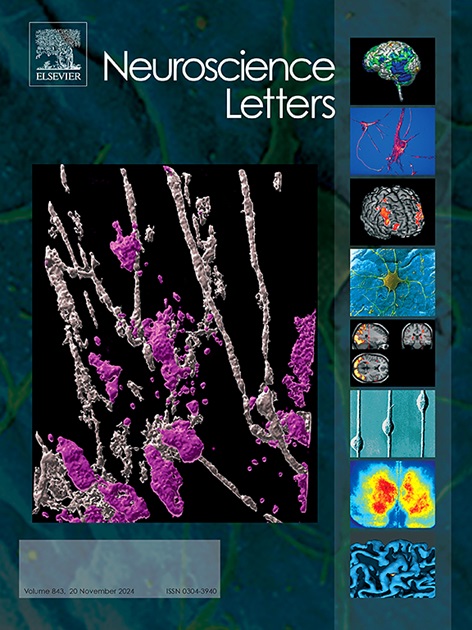Agmatine diminishes behavioral and endocrine alterations in a rat model of post-traumatic stress disorder
IF 2.5
4区 医学
Q3 NEUROSCIENCES
引用次数: 0
Abstract
Post-traumatic stress disorder (PTSD), is a severe anxiety disorder characterized by associative fear conditioning. Single prolonged stress (SPS) is a widely accepted reliable animal model to stimulate PTSD. Agmatine is an endogenous neuromodulator of stress; however, its effect on PTSD remains to be investigated. This study explored the role of agmatine in conditioned fear response (CFR) in PTSD and highlighted the role of imidazoline receptors in the effect of agmatine. Intra-cerebroventricular (icv) surgery was done in order to facilitate drug administration. Animals were subjected to SPS. Agmatine and the involvement of imidazoline receptors (I1 and I2) were assessed for their effect in fear conditioning apparatus. During weeks 1, 2, and 3, in CFR, agmatine (40 µg/rat, icv) showed significantly decreased freezing time whereas other doses of agmatine (10 and 20 µg/rat, icv). Imidazoline (I1 and I2) receptor agonists Moxonidine (25 µg/rat, icv) and 2-BFI, (10 µg/rat, icv) respectively, at their sub-effective doses, with a submaximal dose of agmatine (20 µg/rat, icv) significantly decreased the altered freezing time during weeks 1, 2 and 3 compared to SPS animals. Moreover, the effective dose of agmatine (40 µg/rat, icv) with imidazoline (I1 and I2) receptor antagonists Efaroxan (10 µg/rat, icv) and Idazoxan (4 µg/rat, icv) respectively does not reversed the effect of agmatine on freezing. Agmatine and its combination with I1 and I2 agonists, normalized the altered freezing behavior, corticosterone level, organ coefficient of adrenal gland, neuroinflammatory and neurotrophic factor due to SPS during CFR projecting its strong therapeutic effect in SPS induced PTSD.
胍丁胺在创伤后应激障碍大鼠模型中减少行为和内分泌改变。
创伤后应激障碍(PTSD)是一种以联想恐惧条件反射为特征的严重焦虑障碍。单次延长应激(SPS)是一种被广泛接受的可靠的创伤后应激障碍动物模型。胍丁氨酸是一种内源性应激神经调节剂;然而,其对创伤后应激障碍的影响仍有待研究。本研究探讨了胍丁氨酸在创伤后应激障碍条件恐惧反应(CFR)中的作用,并强调咪唑啉受体如何参与胍丁氨酸的作用。为方便给药,行脑室内手术。动物接受SPS。评估了胍丁氨酸和咪唑啉受体(I1和I2)在恐惧调节装置中的作用。在第1、2和3周,在CFR中,与其他剂量的胍丁氨酸(10和20 µg/大鼠,icv)相比,胍丁氨酸(40 µg/大鼠,icv)的冷冻时间显著缩短。咪唑啉(I1和I2)受体激动剂莫索尼定(25 µg/大鼠,icv)和2- bfi(10 µg/大鼠,icv)的亚有效剂量和亚极大剂量的胍丁氨酸(20 µg/大鼠,icv)与SPS动物相比,显著减少了第1、2和3周的冰冻时间。此外,胍丁氨酸(40 µg/大鼠,icv)与咪唑啉(I1和I2)受体拮抗剂依法罗森(10 µg/大鼠,icv)和依唑嗪(4 µg/大鼠,icv)的有效剂量分别对冷冻效果无显著影响。胍丁氨酸及其与I1和I2激动剂的联合,使CFR期间SPS引起的冻结行为改变正常化,这表明它对SPS诱发的ptsd的CFR有很强的治疗意义。
本文章由计算机程序翻译,如有差异,请以英文原文为准。
求助全文
约1分钟内获得全文
求助全文
来源期刊

Neuroscience Letters
医学-神经科学
CiteScore
5.20
自引率
0.00%
发文量
408
审稿时长
50 days
期刊介绍:
Neuroscience Letters is devoted to the rapid publication of short, high-quality papers of interest to the broad community of neuroscientists. Only papers which will make a significant addition to the literature in the field will be published. Papers in all areas of neuroscience - molecular, cellular, developmental, systems, behavioral and cognitive, as well as computational - will be considered for publication. Submission of laboratory investigations that shed light on disease mechanisms is encouraged. Special Issues, edited by Guest Editors to cover new and rapidly-moving areas, will include invited mini-reviews. Occasional mini-reviews in especially timely areas will be considered for publication, without invitation, outside of Special Issues; these un-solicited mini-reviews can be submitted without invitation but must be of very high quality. Clinical studies will also be published if they provide new information about organization or actions of the nervous system, or provide new insights into the neurobiology of disease. NSL does not publish case reports.
 求助内容:
求助内容: 应助结果提醒方式:
应助结果提醒方式:


